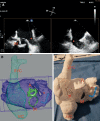Complex transcatheter left atrial appendage closure using a tailored trans-jugular approach simulated by 3D printing: a case report
- PMID: 35965604
- PMCID: PMC9366637
- DOI: 10.1093/ehjcr/ytac304
Complex transcatheter left atrial appendage closure using a tailored trans-jugular approach simulated by 3D printing: a case report
Abstract
Background: Transcatheter left atrial appendage (LAA) closure (LAAc) is less feasible in patients with unusual LAA anatomy.
Case summary: A 65-year-old woman with persistent atrial fibrillation was referred for LAAc. Transesophageal echocardiography (TEE) revealed spontaneous contrast in the LAA without formation of a thrombus; the LAA shape was tortuous and difficult to assess. A first LAAc procedure was unsuccessful given the unsuitable sheath position. Therefore, a soft three-dimensional (3D) model printing was performed by laser sintering and revealed excessive sheath kinking with an inferior approach, but successful deployment would be feasible using a superior approach. Successful trans-jugular implantation of a Watchman FLX 31 device in stable position without residual leakage was achieved during the subsequent procedure. At 3-month follow-up, and after cessation of oral anticoagulation, the patient's symptoms improved. Imaging demonstrated complete LAA occlusion and correct placement of the device along the LAA superior axis.
Discussion: This is the first-reported clinical case of a complex transcatheter LAAc through a trans-jugular approach. Simulating the patient's anatomy with a laser sintering 3D-printed model showed why the transfemoral approach failed, validated the trans-jugular procedure, enabled selection of the simple curve access sheath that had the most direct trajectory towards the LAA, confirmed that transseptal puncture was possible, allowed determination of the angle of puncture, enabled selection of the most appropriate LAA device and had a very low cost compared with planning software or other printing methods.
Keywords: 3D printing; Case report; Left atrial appendage; Percutaneous closure; Preprocedural planning and simulation; Trans-jugular; Transseptal puncture.
© The Author(s) 2022. Published by Oxford University Press on behalf of the European Society of Cardiology.
Figures



References
-
- Hindricks G, Potpara T, Dagres N, Arbelo E, Bax JJ, Blomström-Lundqvist C, Boriani G, Castella M, Dan GA, Dilaveris PE, Fauchier L, Filippatos G, Kalman JM, La Meir M, Lane DA, Lebeau JP, Lettino M, Lip GYH, Pinto FJ, Thomas GN, Valgimigli M, Van Gelder IC, Van Putte BP, Watkins CL; ESC Scientific Document Group . 2020 ESC guidelines for the diagnosis and management of atrial fibrillation developed in collaboration with the European Association for Cardio-Thoracic Surgery (EACTS): the task force for the diagnosis and management of atrial fibrillation of the European Society of Cardiology (ESC) developed with the special contribution of the European Heart Rhythm Association (EHRA) of the ESC. Eur Heart J 2021;42:373–498. - PubMed
-
- Reddy VY, Doshi SK, Sievert H, Buchbinder M, Neuzil P, Huber K, Halperin JL, Holmes D; PROTECT AF Investigators . Percutaneous left atrial appendage closure for stroke prophylaxis in patients with atrial fibrillation: 2.3-year follow-up of the PROTECT AF (Watchman left atrial appendage system for embolic protection in patients with atrial fibrillation) trial. Circulation 2013;127:720–729. - PubMed
-
- Reddy VY, Gibson DN, Kar S, O’Neill W, Doshi SK, Horton RP, Buchbinder M, Gordon NT, Holmes DR. Post-Approval U.S. Experience with left atrial appendage closure for stroke prevention in atrial fibrillation. J Am Coll Cardiol 2017;69:253–261. - PubMed
-
- January CT, Wann LS, Calkins H, Chen LY, Cigarroa JE, Cleveland JC, Ellinor PT, Ezekowitz MD, Field ME, Furie KL, Heidenreich PA, Murray KT, Shea JB, Tracy CM, Yancy CW. 2019 AHA/ACC/HRS focused update of the 2014 AHA/ACC/HRS guideline for the management of patients with atrial fibrillation: a report of the American College of Cardiology/American Heart Association task force on clinical practice guidelines and the Heart Rhythm Society. J Am Coll Cardiol 2019;74:104–132. - PubMed
-
- Glikson M, Wolff R, Hindricks G, Mandrola J, Camm AJ, Lip GYH, Fauchier L, Betts TR, Lewalter T, Saw J, Tzikas A, Sternik L, Nietlispach F, Berti S, Sievert H, Bertog S, Meier B. EHRA/EAPCI expert consensus statement on catheter-based left atrial appendage occlusion—an update. EuroIntervention 2020;15:1133–1180. - PubMed
Publication types
LinkOut - more resources
Full Text Sources
